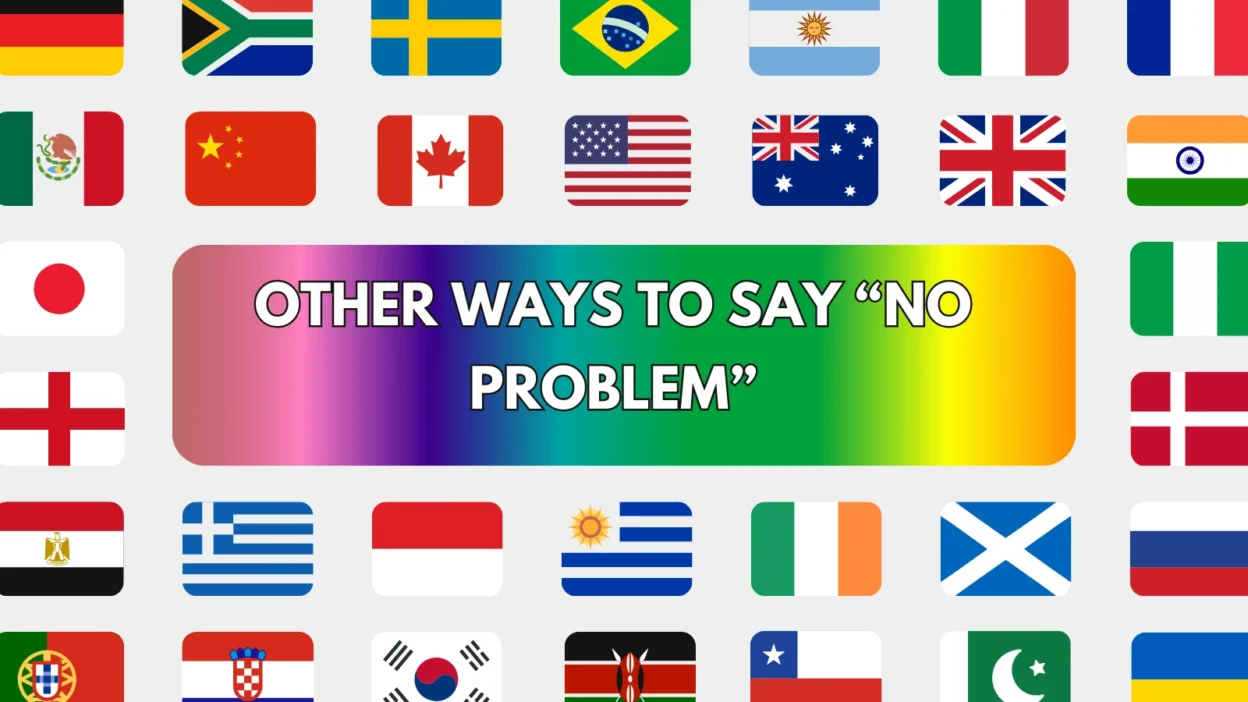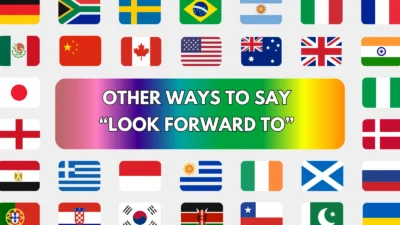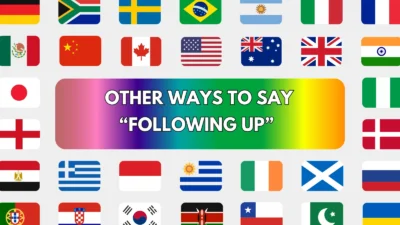The phrase “No problem” is a common and casual way to respond to thanks, requests, or apologies. While it’s friendly and widely accepted, relying on it too often can sound repetitive or too relaxed in formal settings. Exploring different ways to say “No problem” can help you sound more professional, sincere, or empathetic — depending on the context.
Here are 25 great alternatives to “No Problem”, each explained clearly so you can use the best one in any situation.
1. You’re Welcome
Meaning:
A standard and polite response to someone expressing gratitude.
Detailed Explanation:
This is the most formal and traditional alternative, suitable for all settings.
Scenario Example:
Thanks for helping me with the report! — You’re welcome!
Best Use:
Emails, professional conversations, general replies.
Tone:
Polite, neutral.
2. My Pleasure
Meaning:
Expresses that you were happy to help.
Detailed Explanation:
A warm and slightly more refined version of “No problem,” often used in service settings.
Scenario Example:
Thank you for the quick turnaround! — My pleasure.
Best Use:
Customer service, formal communication.
Tone:
Courteous, warm.
3. Anytime
Meaning:
You’re willing to help whenever needed.
Detailed Explanation:
Adds a friendly and ongoing sense of availability to your response.
Scenario Example:
Thanks for the advice! — Anytime.
Best Use:
Informal chats, casual business settings.
Tone:
Friendly, relaxed.
4. Don’t Mention It
Meaning:
The help you gave was no big deal and doesn’t need acknowledgment.
Detailed Explanation:
A modest way to downplay your effort while still showing kindness.
Scenario Example:
I appreciate you helping me with that project. — Don’t mention it.
Best Use:
Informal conversations, spoken replies.
Tone:
Modest, casual.
5. No Worries
Meaning:
There’s no need for concern or gratitude — everything is fine.
Detailed Explanation:
Very casual and conversational; popular in Australian and British English.
Scenario Example:
Sorry for the delay. — No worries!
Best Use:
Text messages, relaxed conversations.
Tone:
Informal, easygoing.
6. Happy to Help
Meaning:
Shows that you were glad to assist.
Detailed Explanation:
This phrase conveys positivity and a helpful attitude.
Scenario Example:
Thanks for the clarification! — Happy to help.
Best Use:
Workplace conversations, customer interactions.
Tone:
Helpful, professional.
7. Of Course
Meaning:
Naturally, or obviously — no need to thank.
Detailed Explanation:
It feels reassuring and confident, like help was guaranteed.
Scenario Example:
Thanks for taking care of that! — Of course!
Best Use:
Friendly but confident responses.
Tone:
Supportive, affirming.
8. Absolutely
Meaning:
Strong agreement or willingness to help.
Detailed Explanation:
Short, punchy, and often used to agree to a request or express willingness.
Scenario Example:
Can you help me with this task? — Absolutely.
Best Use:
Quick replies, enthusiastic conversations.
Tone:
Positive, upbeat.
9. Sure Thing
Meaning:
An informal way to express agreement or readiness.
Detailed Explanation:
It feels casual and cooperative, often used in verbal or text replies.
Scenario Example:
Can I borrow your notes later? — Sure thing!
Best Use:
Friendly chats, informal work settings.
Tone:
Casual, friendly.
10. Not at All
Meaning:
Denies any inconvenience — it was no trouble.
Detailed Explanation:
Slightly formal and polite, often used to reassure someone.
Scenario Example:
I hope I didn’t interrupt your work. — Not at all.
Best Use:
Polite conversations, formal replies.
Tone:
Gracious, composed.
11. It Was Nothing
Meaning:
Minimizes the effort made, in a kind way.
Detailed Explanation:
Suggests the favor or help was minor and doesn’t deserve thanks.
Scenario Example:
Thanks for the quick response. — It was nothing!
Best Use:
Friendly messages, spoken replies.
Tone:
Casual, humble.
12. I’m Always Here If You Need Anything
Meaning:
Offers ongoing support and help.
Detailed Explanation:
Goes beyond the usual “no problem” and makes the person feel supported.
Scenario Example:
Thanks for helping me through this. — I’m always here if you need anything.
Best Use:
Personal messages, emotional support.
Tone:
Reassuring, kind.
13. Consider It Done
Meaning:
Shows confidence that the request or task will be completed.
Detailed Explanation:
Often used when you’ve already helped or plan to — and want to sound efficient.
Scenario Example:
Can you finalize the edits? — Consider it done.
Best Use:
Task responses, team collaboration.
Tone:
Efficient, confident.
14. Glad I Could Help
Meaning:
Shows satisfaction in being useful.
Detailed Explanation:
More personal than “no problem” and reflects genuine support.
Scenario Example:
Thanks again for your input! — Glad I could help.
Best Use:
Professional follow-ups, friendly support.
Tone:
Warm, encouraging.
15. It’s All Good
Meaning:
Everything is fine — no need to worry or thank.
Detailed Explanation:
A laid-back expression that’s better for informal settings.
Scenario Example:
Sorry about the confusion. — It’s all good!
Best Use:
Casual messages, personal chats.
Tone:
Relaxed, informal.
16. Think Nothing of It
Meaning:
The action wasn’t important enough to deserve gratitude.
Detailed Explanation:
Often used in old-fashioned or very polite English.
Scenario Example:
I’m grateful for your help. — Think nothing of it.
Best Use:
Polite replies, formal notes.
Tone:
Gracious, traditional.
17. Sure!
Meaning:
An enthusiastic “yes” to a request.
Detailed Explanation:
Very short and casual; best when responding quickly.
Scenario Example:
Can you send me the slides? — Sure!
Best Use:
Chat messages, peer communication.
Tone:
Casual, quick.
18. It’s No Trouble at All
Meaning:
Assures the person that the action didn’t cause any difficulty.
Detailed Explanation:
Reassuring and formal, good when people apologize for asking.
Scenario Example:
Thanks for your time. — It’s no trouble at all.
Best Use:
Client communication, service settings.
Tone:
Polite, professional.
19. No Big Deal
Meaning:
Minimizes the action or effort involved.
Detailed Explanation:
Very casual, almost slang — best among friends or peers.
Scenario Example:
Sorry for the late message. — No big deal!
Best Use:
Informal conversations.
Tone:
Relaxed, friendly.
20. It Was the Least I Could Do
Meaning:
You did something minimal compared to what they needed or deserved.
Detailed Explanation:
Adds a humble and kind tone to your gratitude response.
Scenario Example:
Thanks for the gift! — It was the least I could do.
Best Use:
Emotional support, thoughtful gestures.
Tone:
Modest, caring.
21. Absolutely No Problem
Meaning:
A stronger version of “No problem” for added reassurance.
Detailed Explanation:
Sounds more enthusiastic and eliminates any hint of inconvenience.
Scenario Example:
Thanks for staying late. — Absolutely no problem!
Best Use:
Team replies, customer responses.
Tone:
Friendly, reassuring.
22. Not a Problem at All
Meaning:
Strongly denies that there was any issue helping.
Detailed Explanation:
Adds emphasis and warmth to your reply.
Scenario Example:
Thanks again for your help. — Not a problem at all.
Best Use:
Emails, phone conversations.
Tone:
Supportive, kind.
23. It’s the Least I Could Do
Meaning:
You felt compelled to help in any way you could.
Detailed Explanation:
Good for emotional or sympathetic replies.
Scenario Example:
Thanks for everything. — It’s the least I could do.
Best Use:
Personal messages, kind gestures.
Tone:
Humble, heartfelt.
24. I’ve Got You Covered
Meaning:
You’ve taken care of the issue or task.
Detailed Explanation:
Shows reliability and support in a friendly way.
Scenario Example:
Thanks for handling that while I was out. — I’ve got you covered.
Best Use:
Team environments, casual workplace talk.
Tone:
Supportive, dependable.
25. That’s What I’m Here For
Meaning:
Helping is part of your role or what you enjoy doing.
Detailed Explanation:
It sounds comforting and lets others know you’re dependable.
Scenario Example:
Thanks for always being available! — That’s what I’m here for.
Best Use:
Customer service, internal teams.
Tone:
Helpful, reassuring.
Conclusion
Saying “No Problem” works just fine — but these 25 smart alternatives give you more flexibility to match the tone and relationship of your conversation. Whether you’re aiming for professional, friendly, casual, or heartfelt, having more options makes you a stronger communicator.




